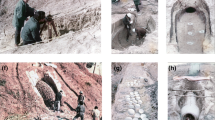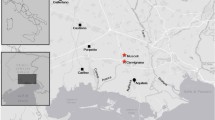Abstract
The ability of baked clay-elaborated objects to record the temporal variations of both direction and intensity of the geomagnetic field at the time of their elaboration or last use has been widely used during the last decades to fill the gaps left by available time-discrete volcanic-rock logs for a better knowledge of the evolution of the geomagnetic field. Further refinement of the secular variation curves has motivated the search for alternative non-conventional materials as attractive targets for archeomagnetic studies. Both clay and copper have been used since pre-Hispanic times for the elaboration of a wide variety of ornamental and utilitarian objects in Mesoamerica. Previous studies carried out in Europe and Israel have shown the usefulness of copper slags as one of these non-conventional materials. We present the results of an integrated study carried out on ten copper slags from seven ancient metallurgical sites of Michoacán. The analysis included a series of rock magnetism experiments, scanning electron microscope analysis, archeointensity determinations following the Thellier-Coe method and their corresponding dating. Based on the results obtained the slag-set analyzed can be divided in two main groups: low Fe concentrations (associated with high Cu concentrations) for slags comprising the first group, and high Fe concentrations (associated with low Cu concentrations) for slags from second group. Slags from the first group are characterized by almost reversible thermomagnetic curves, while those corresponding to the second group show a quite irreversible behavior. A crystalline (vitreous) structure within the massive surface of the slags is observed for those coming from the second (first) group. These striking features could reflect significant differences in the metallurgical process followed at these sites, which according to archeological and historical evidences correspond to Colonial and pre-Hispanic usage metallurgical sites; first and second group, respectively. The good experimental behavior exhibited by these materials demonstrates the suitability of copper slag to obtaining absolute archeointensity data which can be used to improve the existing Mesoamerican archeomagnetic record. This in turn, can be used both for geomagnetic field modelling purposes and archeomagnetic dating.
Similar content being viewed by others
References
Ben-Yosef E., Ron H., Tauxe L., Agnon A., Genevey A., Levy T.E., Avner U. and Najjar M., 2008. Application of copper slag in geomagnetic archeointensity research. J. Geophys. Res., 113, B08101, DOI: 10.1029/2007JB005235.
Cárdenas E. and Fernández-Villanueva E. 2004. La metalurgia en Santa Clara del Cobre: ¿una tradición prehispánica? In: Feder-Nadoff M. (Ed.), Ritmo del Fuego. Cuentos Foundation, Chicago, IL (in Spanish).
Carrancho Á., Morales J., Goguichaichvili A., Alonso R. and Terradillos M., 2014. Thermomagnetic monitoring of lithic clasts burned under controlled temperature and field conditions. Implications for Archeomagnetism. Geofis. Int., 53, 473–490.
Carrancho Á., Gogichaishvili A., Kapper L., Morales J., Soler Arechalde A.M. and Tema E., 2015. Geomagnetic applications in archeology: state of the art and recent advances. In: Eppelbaum L.V. (Ed.), New Developments in Paleomagnetism Research. Nova Science Publishers, New York, 53–98.
Coe R.S., 1967. Paleo-intensities of the Earth’s magnetic field determined from Tertiary and Quaternary rocks. J. Geophys. Res., 72, 3247–3262.
Coe R.S., Grommé S. and Mankinen E.A., 1978. Geomagnetic paleointensities from radiocarbondated lava flows on Hawaii and the question of the Pacific nondipole low. J. Geophys. Res., 83, 1740–1756.
Costanzo-Álvarez V., Suárez N., Aldana M., Hernández M.C. and Campos C., 2006. Preliminary dielectric and rock magnetic results for a set of prehistoric Amerindian pottery samples from different Venezuelan Island. Earth Planets Space, 58, 1423–1431.
Gallet Y., Genevey A. and Le Goff M., 2002. Three millennia of directional variation of the Earth’s magnetic field in western Europe as revealed by archeological artefacts. Phys. Earth Planet. Inter., 131, 81–89.
Goguitchaichvili A., Soler A.M., Zanella E., Chiari G., Lanza R., Urrutia-Fucugauchi J. and Gonzales T., 2004. Pre-Columbian mural paintings from Mesoamerica as geomagnetic field recorders. Geophys. Res. Lett., 31, L12607, DOI: 10.1029/2004GL020065.
Gram-Jensen M., Abrahamsen N. and Chauvin A., 2000. Archeomagnetic intensity in Denmark. Phys. Chem. Earth A, 25, 525–531.
Kosterov A.A., Perrin M., Glen J.M. and Coe R.S., 1998. Paleointensity of the eEarth’s magnetic field in early Cretaceous time: The Parana Basalt, Brazil. J. Geophys. Res., 103, 9739–9753, DOI: 10.1029/98JB00022.
Levi S., 1977. The effect of magnetite particle size on paleointensity determinations of the geomagnetic field. Phys. Earth Planet. Inter., 13, 245–259.
Maldonado B. 2006. Preindustrial Copper Production at the Archaeological Site of Itziparatzico, a Tarascan Location in Michoacan, Mexico. PhD Thesis. Pennsylvania State University, University Park, PA.
Morales J., Goguitchaichvili A., Acosta G., Gonzalez-Moran T., Alva-Valdivia L., Robles-Camacho J. and Hernandez-Bernal M., 2009. Magnetic properties and archeointensity determination on Pre-Columbian pottery from Chiapas, Mesoamerica. Earth Planets Space, 61, 83–91.
Morales J., Goguitchaichvili A., Aguilar-Reyes B., Pineda-Duran M., Camps P., Carvallo C. and Calvo-Rathert M., 2011. Are ceramics and bricks reliable absolute geomagnetic intensity carriers? Phys. Earth Planet. Inter., 187, 310–321, DOI: 10.1016/j.pepi.2011.06.007.
Morales J., Goguitchaichvili A., Aguilar Reyes B., Pineda M., Carvallo C., Beramendi L., Hernandez G. and Oliveros A., 2012. A detailed rock-magnetic and archeointensity investigation on some pottery relics and burned floors from Tzintzuntzan archeological site, Western Mesoamerica. Geoarchaeology, 27, 521–537, DOI: 10.1002/gea.21426.
Morales J., Fernández Martínez G., Gogichaisvilli A., Cárdenas E. and Hernández-Bernal M.S., 2015. Archeomagnetic dating of some Pre-Columbian pottery fragments from Northern Mesoamerica: Implications for the chronology of Central Mexico during the Epiclassic period. J. Archaeol. Sci. Rep, 4, 32–43, DOI: 10.1016/j.jasrep.2015.08.027.
Pavón-Carrasco F.J., Rodriguez-Gonzalez J., Osete M.L. and Torta J., 2011. A Matlab tool for archaeomagnetic dating. J. Archaeol. Sci., 38, 408–419.
Pavón-Carrasco F.J., Osete M.L., Torta J.M. and De Santis A., 2014. A geomagnetic field model for the Holocene based on archaeomagnetic and lava flow data. Earth Planet. Sci. Lett., 388, 98–109, DOI: 10.1016/j.epsl.2013.11.046.
Punzo-Díaz J.L., Morales J. and Goguitchaichvili A., 2015. Evidencias de escorias de cobre prehispánicas en el área de Santa Clara del Cobre, Michoacán, Occidente de México. Arqueología Iberoamericana, 28, 46–51.
Rada M., Costanzo-Álvarez V., Aldana M. and Campos C., 2008. Rock magnetic and petrographic characterization of prehistoric Amerindian ceramics from the Dos Mosquises Island (Los Roques, Venezuela). Interciencia, 33, 129–134.
Riisager P. and Riisager J., 2001. Detecting multidomain magnetic grains in Thellier palaeointensity experiments. Phys. Earth Planet. Inter., 125, 111–117.
Schnepp E. and Lanos P., 2005. Archeomagnetic secular variation in Germany during the past 2500 years. Geophys. J. Int., 163, 479–490.
Shaar R., Ron H., Tauxe L., Kessel R., Agnon A., Ben-Yosef E. and Feinberg J.M., 2010. Testing the accuracy of absolute intensity estimates of the ancient geomagnetic field using copper slag material. Earth Planet. Sci. Lett., 290, 201–213, DOI: 10.1016/j.epsl.2009.12.022.
Spassov S., Hus J., Geeranerts R. and Heller F., 2008. Archaeomagnetic dating of a high middle age likely iron working site in Corroy-le-Grand (Belgium). Phys. Chem. Earth, 33, 544–556.
Terán Guerrero A., Goguitchaichvili A., Esparza López R., Morales J., Rosas Elguera J., Soler A.M., Cárdenas E. and Urrutia-Fucugauchi J., 2016. A detailed rock-magnetic and archaeomagnetic investigation on wattle and daub building (Bajareque) remains from Teuchitlán tradition (NW Mesoamerica). J. Archaeol. Sci. Rep., 5, 564–573.
Thellier E., 1936. Détermination de la direction de l’aimantation permanente des roches. C. R. Acad. Sci., 203, 743–744 (in French).
Thellier E. and Thellier O., 1959. Sur l’intensité du champ magnétique terrestre dans le passé historique et géologique. Ann. Géophys., 15, 285–376 (in French).
Author information
Authors and Affiliations
Corresponding author
Rights and permissions
About this article
Cite this article
Morales, J., del Sol Hernández-Bernal, M., Goguitchaichvili, A. et al. An integrated magnetic, geochemical and archeointensity investigation of casting debris from ancient metallurgical sites of Michoacán, Western Mesoamerica. Stud Geophys Geod 61, 290–309 (2017). https://doi.org/10.1007/s11200-016-1033-z
Received:
Revised:
Accepted:
Published:
Issue Date:
DOI: https://doi.org/10.1007/s11200-016-1033-z




